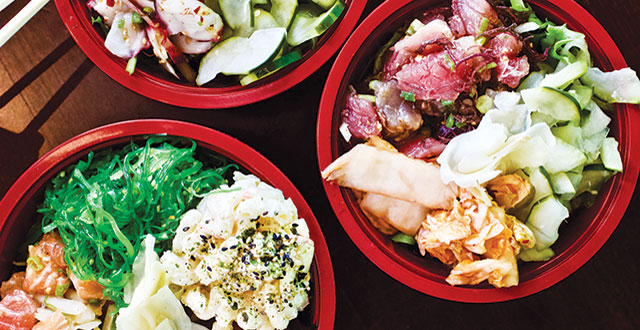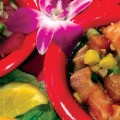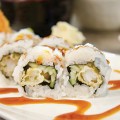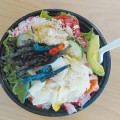The Hawaiian word “poke” (rhymes with “OK” and not “spoke”) means “to cut into chunks.” More popularly, poke is a native Hawaiian pupu (appetizer)—traditionally prepared simply, with freshly caught island fish, sea salt, seaweed and ground kukui nuts. It’s akin to Hawaiian soul food, and what author Rachel Laudan describes as “the thing to have with a beer after work.”
The truth is nobody really knows the origins of poke, as historical food studies of native Hawaiian culture never made reference to it. Poke recipes first began popping up in Hawaiian cookbooks sometime in the mid-1970s. With ingredients such as soy sauce, sesame oil and chili, the dish became a testament to Japanese-Hawaiian fusion.
More recently—much to the horror of some Hawaiians—the word has been associated with a popularized “California-style poke,” which has seen astounding growth in the fast-casual restaurant market here on the mainland. A whole subgenre of these restaurants have dedicated themselves to serving up bowl after bowl of raw fish and rice.
Along with this Californ-ification of poke, we’ve seen the addition of myriad sauces and toppings—such as teriyaki with corn, tomatoes and even potato chips. And, as if that weren’t enough cultural slander, some establishments have changed the spelling to “poki,” while others have added unnecessary diacritics to the name. Read: pokē or poké.
Now, I’m not absolving myself of any sins. I too have partaken in more than my fair share of Cali-style poke because, let’s be honest, it’s delicious and I was unaware of any identity politics in the poke world.
Aloha Fresh is looking to change all that.
This local poke joint is owned by Hawaiians on a mission. They resolve to bring back traditional poke to the South Bay. The restaurant is not new. It got its start back in late 2015 in Cupertino. However, the owners of Aloha Fresh recently relocated their restaurant to San Jose’s Japantown neighborhood.
“People in Japantown understand what we’re all about,” manager Vanessa Nimi says. “In Cupertino, many people were looking for the ‘Chipotle-style,’ where they can choose their sauces and mix and match different flavors. But with Hawaiian-style poke, everything
is pre-marinated.”
Aloha Fresh’s mission begins with delivering the freshest fish possible. Their never-frozen ahi tuna is flown in straight from Hawaii three times a week, and their sustainable salmon can be tracked down to where and when it was caught and by whom. Those fish, along with shrimp, scallops and tako (octopus) are then marinated in a curated selection of house sauces for a grand total of 14 poke options.
Another big reason for the move was that the old Aloha Fresh had no physical kitchen. In Japantown they now have a full spread that allows them to offer hot food like fried chicken, spring rolls and kalua pork. They also have milk teas ($4) and tropical dessert items like guava butter mochi ($2).
Aloha Fresh has only three options for its poke bowls: one scoop ($10.75), two scoops ($13.75) or a “surf ’n’ turf” option with one scoop of poke and a hot food item ($14.50). The bowls come with a base of rice or salad and two sides, such as crab salad, pickled onions or housemade kimchi.
I’ve had a surf ’n’ turf bowl before with their unctuous kalua pork at the Cupertino location, but something about hot protein with cold poke was a bit off-putting to me. So, on my recent visit to the new digs, I opted for two scoops with spicy shoyu ahi, kukui nut salmon and the black rice ($1 extra) as a base. For my sides I chose the seaweed salad and the hard-to-resist Hawaiian mac salad.
One bite into the fish and it’s easy to understand why Aloha Fresh goes out of the way to ensure the freshest catch; the texture and flavor is unlike any other poke I’ve tasted. The spicy shoyu had a well-balanced flavor of salt, ginger and a bit of a kick from the chili oil, gently warming my mouth, while the kukui nut salmon had a savory blend of sesame oil and sweet onions that enhanced the flavor of the fish.
For me, the black rice is a no-brainer; its earthy flavor and toothsome bite is well worth the slight upcharge. The mac salad’s pasta is cooked perfectly soft, well-seasoned with mayo and occasional flecks of sesame seeds. The seaweed salad offered a fresh respite from all the earth, salt and sweet in my bowl.
Paying heed to cultural dishes’ origins is an uphill battle, but it’s worth it to prevent cultural appropriation by overzealous restaurateurs—and to get a taste of the genuine article.
Aloha Fresh
225 Jackson St, San Jose
408.217.8988
alohafreshpoke.com

 Celebrate Oktoberfest in Silicon Valley with beer, brats and more beer
Celebrate Oktoberfest in Silicon Valley with beer, brats and more beer  Campbell Civil Cervant Launches P&V Winery
Campbell Civil Cervant Launches P&V Winery 


